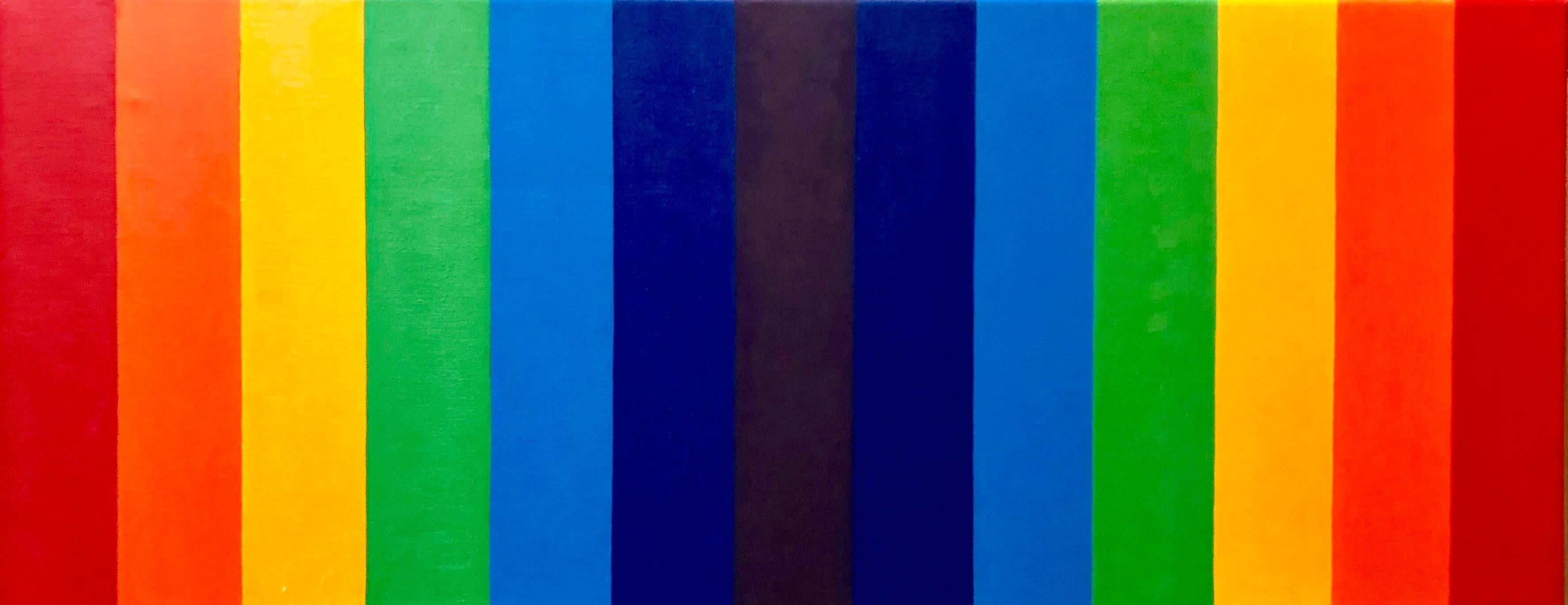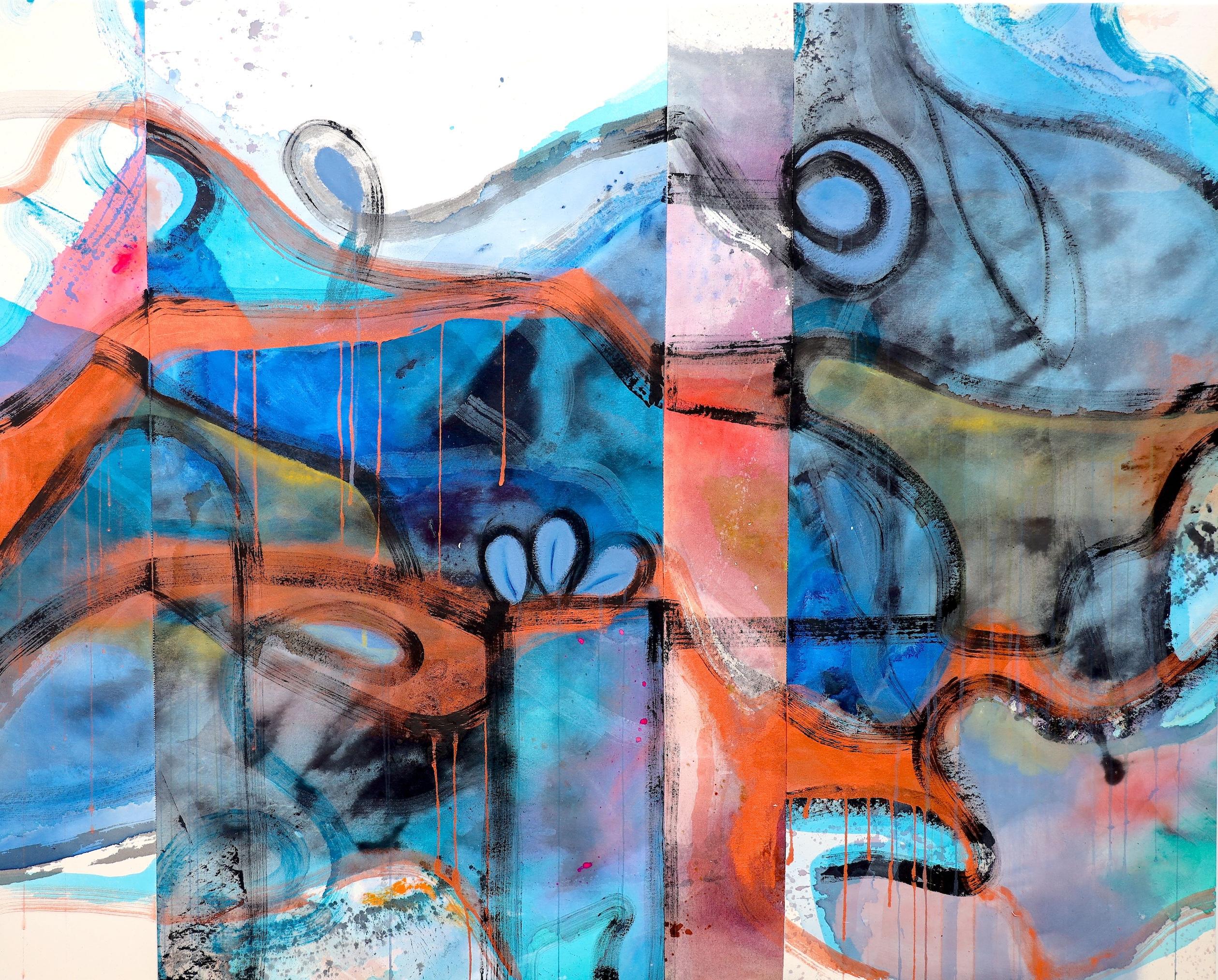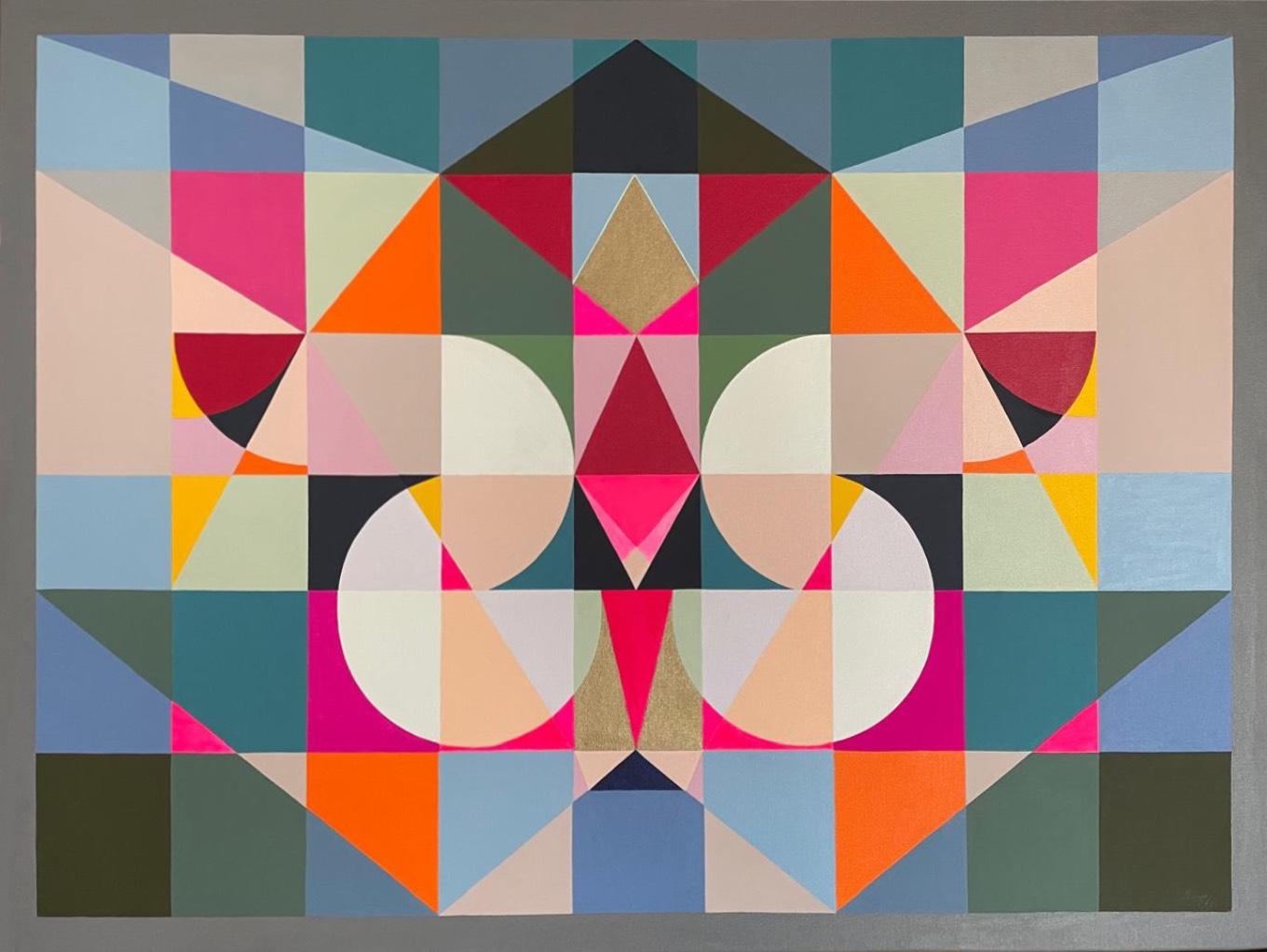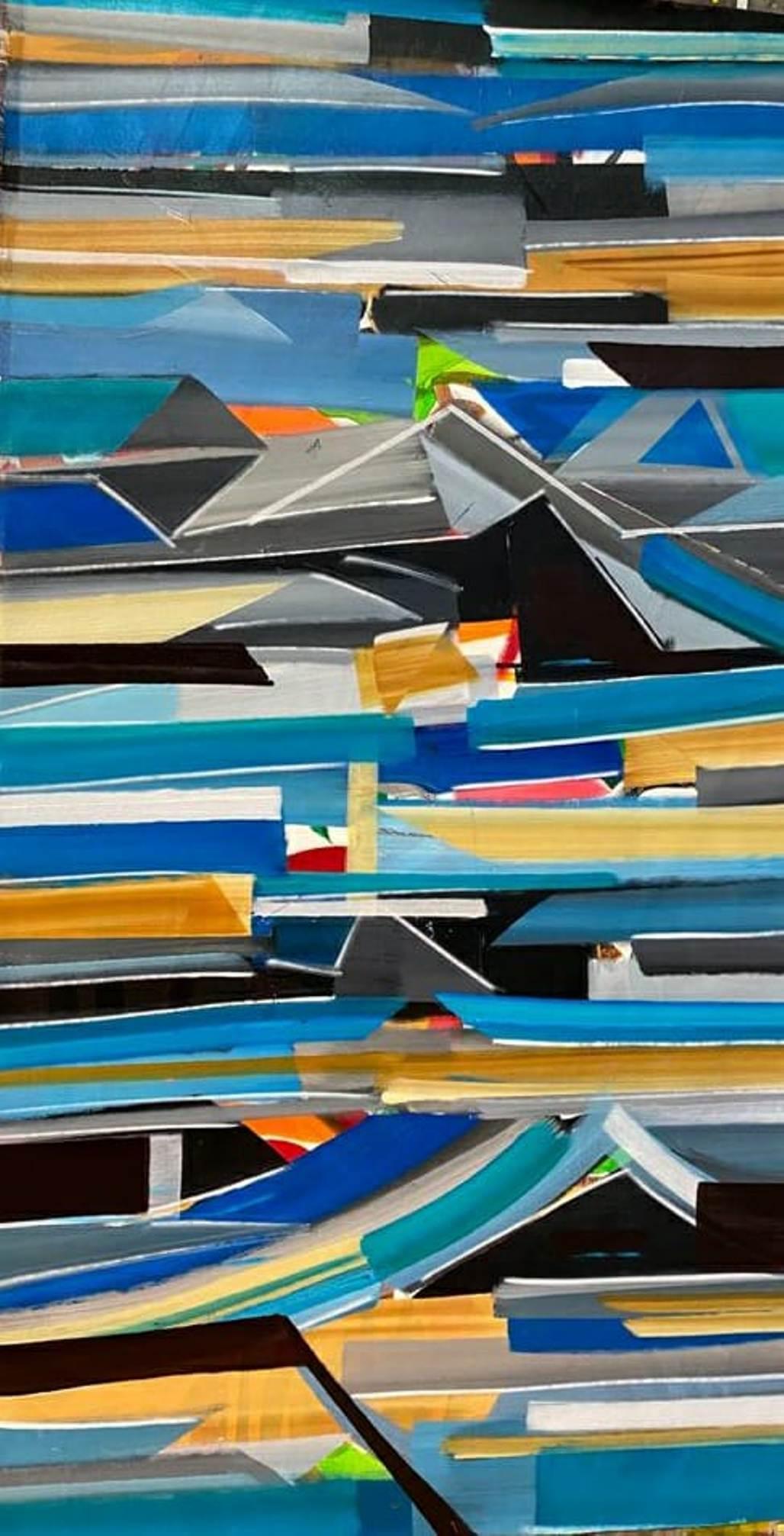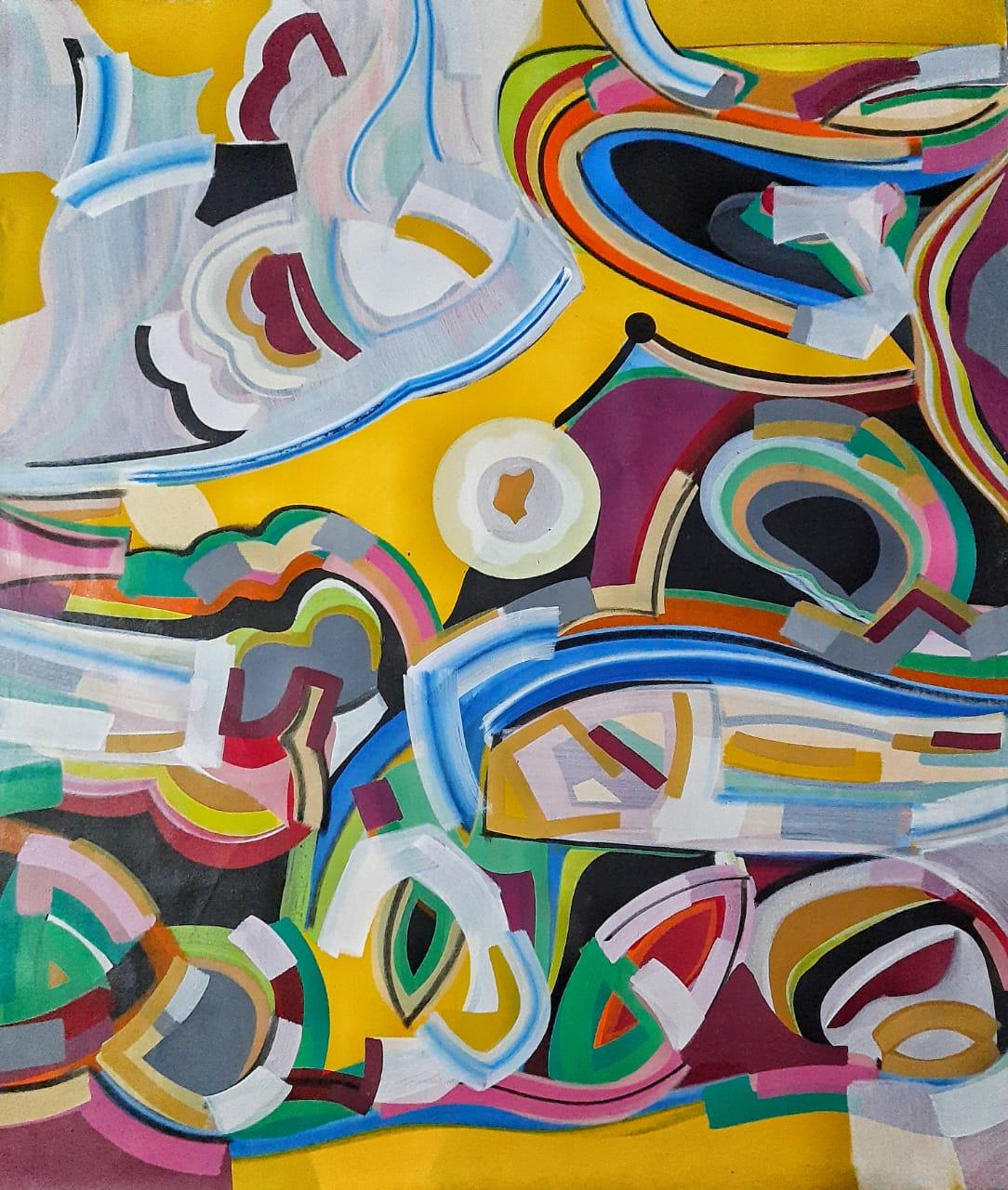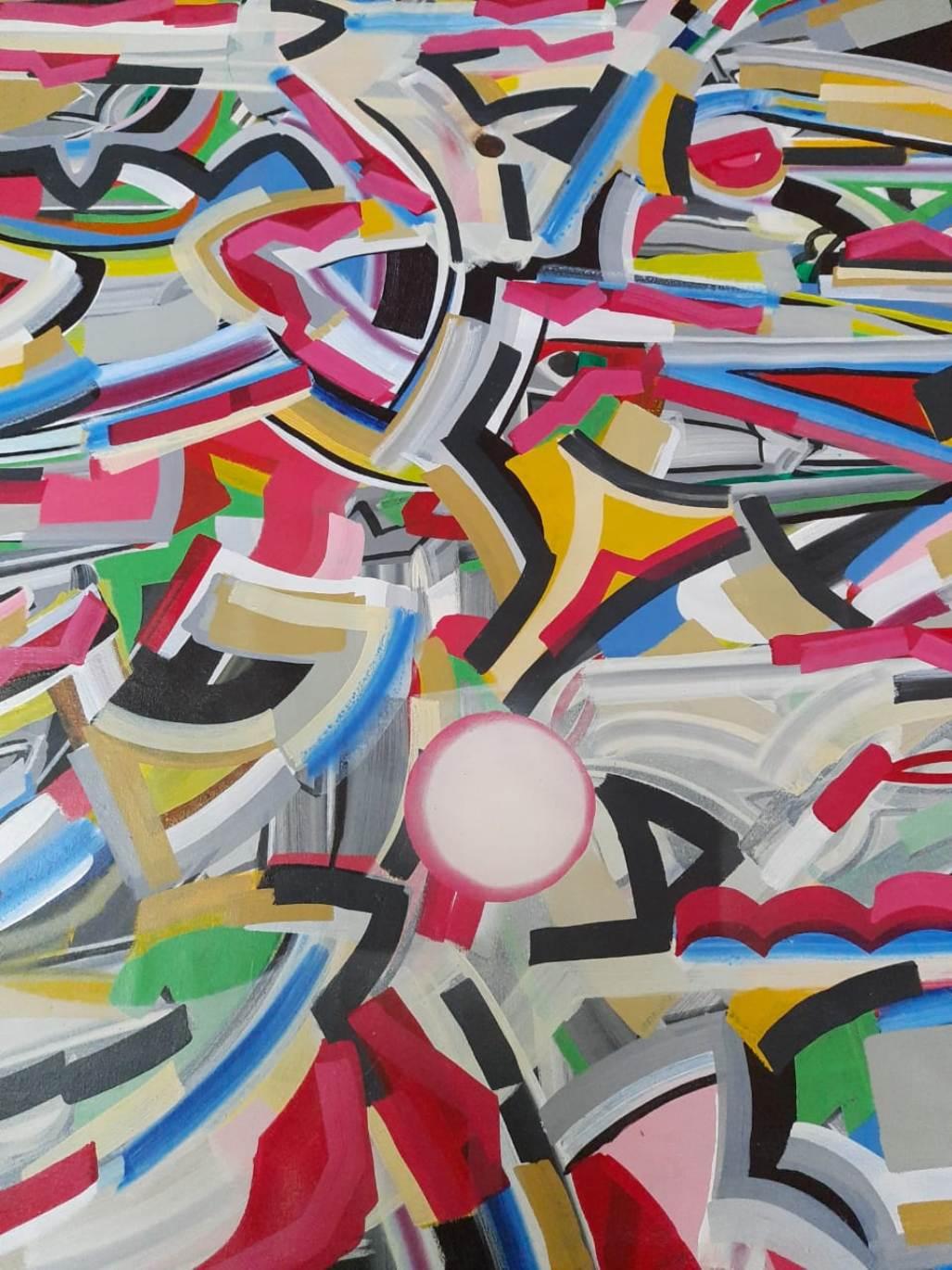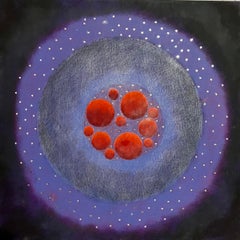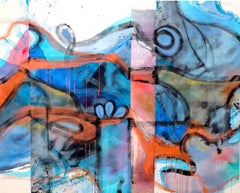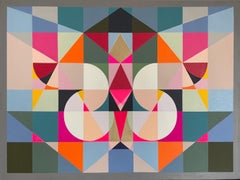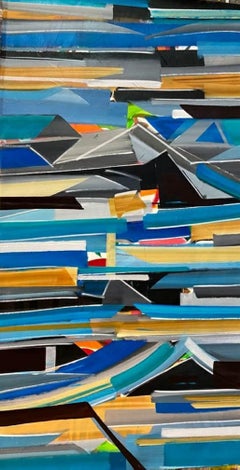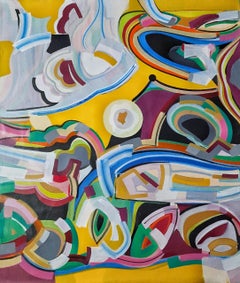Items Similar to Ajapa Jaapa Abstract Geometric Modern Indian Painting
Want more images or videos?
Request additional images or videos from the seller
1 of 10
Jeet AulakhAjapa Jaapa Abstract Geometric Modern Indian Painting2007
2007
$750
£574.69
€661.03
CA$1,072.23
A$1,164.63
CHF 616.58
MX$14,062.23
NOK 7,697.33
SEK 7,291.99
DKK 4,935.84
About the Item
Born and raised in India, Canadian Contemporary artist Jeet Aulakh participates in a rich and varied cultural and social history in which notions of humanity are indivisible into secular and spiritual realms. A central theme in Indian philosophy is the ultimate release from the subservience of life and all its contingent aspects: to be detached from life by the realization of the “absolute supreme principle”, which is itself beyond definition. The goal is to achieve, through inner realization, a reintegration into this indefinable absolute realm. Aulakh ably depicts this other abstract realm through the use of floating circles of saturated colour seemingly floating in the dark to evoke cosmic cycles in which human history and individual identity is peripheral. The radiant world of the enraptured, disembodied soul is undiminished by this enveloping cosmic darkness.
His images suggest a cosmic egg from which the manifest world is born. Striving to reveal through geometric abstraction what remains incomprehensible, Aulakh, through his use of glowing circles of colour, gives form to what is formless and cohesive totality to individual consciousness. Aulakh’s celestial circles are irreducible: they are void of narrative or symbolic content. They suggest the way in which the distinctions between varying avenues to spiritual enlightenment are illusory despite separate names and forms. His is a minimalist and conceptual approach to spirituality informed by the rich history of Indian culture in which one finds countless references to cosmic consciousness.
His work has been exhibited at numerous museums and galleries. He is represented by Rupert Young Toronto.
- Creator:Jeet Aulakh (1971, Canadian, Indian)
- Creation Year:2007
- Dimensions:Height: 11 in (27.94 cm)Width: 11 in (27.94 cm)
- Medium:
- Movement & Style:
- Period:
- Condition:
- Gallery Location:Surfside, FL
- Reference Number:1stDibs: LU38211847722
About the Seller
4.9
Platinum Seller
Premium sellers with a 4.7+ rating and 24-hour response times
Established in 1995
1stDibs seller since 2014
1,815 sales on 1stDibs
Typical response time: 1 hour
- ShippingRetrieving quote...Shipping from: Surfside, FL
- Return Policy
Authenticity Guarantee
In the unlikely event there’s an issue with an item’s authenticity, contact us within 1 year for a full refund. DetailsMoney-Back Guarantee
If your item is not as described, is damaged in transit, or does not arrive, contact us within 7 days for a full refund. Details24-Hour Cancellation
You have a 24-hour grace period in which to reconsider your purchase, with no questions asked.Vetted Professional Sellers
Our world-class sellers must adhere to strict standards for service and quality, maintaining the integrity of our listings.Price-Match Guarantee
If you find that a seller listed the same item for a lower price elsewhere, we’ll match it.Trusted Global Delivery
Our best-in-class carrier network provides specialized shipping options worldwide, including custom delivery.More From This Seller
View AllNAMO EK YOGE, Abstract Geometric Rainbow Composition Painting
By Jeet Aulakh
Located in Surfside, FL
Born and raised in India, Canadian Contemporary artist Jeet Aulakh participates in a rich and varied cultural and social history in which notions of humanity are indivisible into secular and spiritual realms. A central theme in Indian philosophy is the ultimate release from the subservience of life and all its contingent aspects: to be detached from life by the realization of the “absolute supreme principle”, which is itself beyond definition. The goal is to achieve, through inner realization, a reintegration into this indefinable absolute realm. Aulakh ably depicts this other abstract realm through the use of floating circles of saturated colour seemingly floating in the dark to evoke cosmic cycles in which human history and individual identity is peripheral. The radiant world of the enraptured, disembodied soul is undiminished by this enveloping cosmic darkness.
His images suggest a cosmic egg...
Category
21st Century and Contemporary Contemporary Abstract Paintings
Materials
Canvas, Acrylic
1960s Swiss Postwar Contemporary Geometric Abstract Painting on Metal Jean Baier
By Jean Baier
Located in Surfside, FL
Jean Baier (Swiss, 1932-1999)
"Composition"
1960
An original enamel composition on metal wall mount art. This post war contemporary work features geometric abstract designs character...
Category
1960s Abstract Geometric Abstract Paintings
Materials
Metal
Large Modernist Geometric Abstract Painting
By Gregg Robinson
Located in Surfside, FL
Gregg Robinson, American (born 1948) "Cipher Bar 19" Oil on Canvasboard Panel. Artist signed, title and dated 1990 far right. Very minor rubbing to paint. Panel measures 15-1/4" H x 63-1/2" W, frame measures 24-1/4" H x 72-1/4" W
GREGG ROBINSON
The universe of visual art encompasses a huge spectrum of motivation and means of expression. Examples range from the most syrupy sentimentality to extremes of moral and intellectual confrontation. For me, the creative process is, on the simplest level, an aesthetic puzzle. Elements of the puzzle include contrast, color, visual texture, graphic pattern, and in some recent work, a simple cryptic symbolism.
I have never been particularly interested in lyric or pictorial content, and though some of my work does contain undeniable spatial illusion, even that tends to be a by-product rather than a goal of the primary pursuit: the balance of light and dark, pure color and organic neutrals, energy and calm, strong pattern and subtle field. Having grown up in an environment of contemporary architecture, I have always valued the classic modern synthesis of form and function exemplified by the Bauhaus movement of the early 20th century. Hence, the simplest solutions are often the most satisfying. Obviously, the modernist ideal of efficiency in form and function requires that method of execution be as well adapted to the aesthetic goal as the visual language itself.
The media before you is the result of many years of experimentation that came to its current form in early 1992. I work with dry pigment over a plaster surface. My tools are broad knives, sponges, rags and masking. The finish is a high gloss alkyd resin.
CORPORATE COLLECTIONS:
Allstate Insurance
NBC Productions
Alaska...
Category
1990s Contemporary Abstract Paintings
Materials
Canvas, Mixed Media, Oil, Board
Color Gradient Geometric Collage Painting New York School Abstract Expressionist
By Paul Brach
Located in Surfside, FL
Paul Brach (American, 1924-2007).
Cluster #3
Acrylic on canvas with collage metal stars on it.
Paul Henry Brach, (born March 13, 1924 in New York City - d.November 16, 2007 in Easthampton, New York) was an American abstract painter and a lecturer and educator.
As an abstract painter Paul Brach exhibited his work in New York with the Leo Castelli Gallery, the Cordier & Eckstrom Gallery, and with the André Emmerich Gallery and then later with Flomenhaft Gallery. Paul Brach's estate is represented exclusively by Eric Firestone Gallery.
Paul Brach was born in New York City and was raised in Brooklyn and the Bronx. He went to the University of Iowa where he studied painting with Grant Wood. He served in the US Army during World War II. After the war, he finished school in Iowa on the GI Bill. At the University of Iowa he met the artist Miriam Schapiro and in 1946 they married. By 1951 they moved back to New York City and befriended many of the artists in the downtown Abstract expressionist New York School, including Joan Mitchell, Larry Rivers, Knox Martin and Michael Goldberg. He was associated with the New York print studio Atelier 17 (Stanley Hayter) During the early 1960s Brach had part-time teaching jobs at The New School, Cooper Union, The Parsons School of Design and Cornell University's New York City Program.
In 1967 Brach and his wife Miriam Schapiro moved to Southern California. He became the Dean of the CalArts program in Los Angeles in 1969. As dean of the School of Art at the California Institute from 1969 to 1975, Mr. Brach hired John Baldessari, Allan Kaprow and the critic Max Kozloff, among
others. He helped to create a freewheeling experimental atmosphere out of which emerged artists like David Salle, Eric Fischl, Barbara Bloom...
Category
Early 2000s Abstract Geometric Abstract Paintings
Materials
Canvas, Acrylic
Modernist American Abstract Expressionist Pop Art Painting on Canvas James Yohe
By James Yohe
Located in Surfside, FL
James Yohe
A Quiet Situation-Move
Acrylic on canvas, 1980,
Hand signed 'Yohe', titled and dated on the reverse, with label from Alexander Milliken Gallery NY.
18 1/2 x 20 1/2 in., t...
Category
1980s Post-Modern Abstract Paintings
Materials
Canvas, Acrylic
Pencil Signed Abstract Geometric Graphic Design Lithograph Print, Bauhaus Artist
By M. Peter Piening
Located in Surfside, FL
M. Peter Piening was born on March 14, 1908 in Grabow, Germany. He began his education at a private school in Italy, studied at the Jesuit school of Kloster Ettal in Bavaria, and attended the German Stettin Gymnasium, where he graduated in 1926. Between 1926 and 1928 Piening studied design at the Bauhaus in Dessau, Germany. There he was taught by multiple famous twentieth-century artists, including Joseph Albers, Paul Klee and Mies van der Rohe. After receiving his master’s degree from the Bauhaus in 1929, Piening enrolled at the University of Berlin and obtained his PhD in philosophy in 1931.
Piening spent his early career free-lancing as an illustrator and artist for various publishing companies, eventually settling in Paris to work for Condé-Nast’s French publication of Vogue. In 1934 he moved to the United States to work in Condé-Nast’s New York City office. For the next two decades, Piening worked for many important advertising agencies and magazine publishers, including the N. W. Ayer and J. Walker Thompson agencies and Life and Fortune magazines. As art director for Life in the 1930s and for Fortune in the 1940s, Piening completely redesigned the layout of each magazine. He also redesigned the layouts for thirty-four other major American magazines, including Town & Country and Cosmopolitan.
Through his design work, Piening had a great impact on the American public, although the millions who encountered his work most likely never knew his name. Between 1934 and 1964, Piening designed over sixty logos and trademarks for internationally-known products and companies. His most widely-recognized logo may have been the three interlocking rings of Ballantine beer. Piening’s other trademark designs include the Lincoln Zephyr...
Category
1960s Abstract Geometric Abstract Prints
Materials
Lithograph
You May Also Like
Do it anyway - Abstract Geometric Acrylic Painting
Located in Boston, MA
Do it anyway
60 x 48 x 2, 9 lbs
Acrylic Painting
Hand signed by artist
Artist's Commentary:
"DO IT ANYWAY. In this piece, vibrant acrylics and expressive oil pastels dance togeth...
Category
21st Century and Contemporary Abstract Geometric Abstract Paintings
Materials
Acrylic
Beej. Abstract Painting
By Neerja Chandna Peters
Located in Miami Beach, FL
Neerja Chandna Peters enjoys navigating harmony through the play of lines with their symmetrical synchrony and rhythmic interplay, manipulating the nuances, their saturation and thei...
Category
2010s Contemporary Abstract Paintings
Materials
Acrylic, Canvas
Abstract, Acrylic on Canvas by Contemporary Indian Artist "In Stock"
By Amit Kalla
Located in Kolkata, West Bengal
Amit Kalla - Abstract - 34 x 60 inches (unframed size)
Acrylic on Canvas
** Free Shipment ...... will be delivered in rolled form.
Style : Kalla’s work can be represented by his com...
Category
2010s Abstract Abstract Paintings
Materials
Canvas, Acrylic
Abstract Painting, Acrylic on Canvas by Contemporary Artist "In Stock"
By Amit Kalla
Located in Kolkata, West Bengal
Amit Kalla - Untitled - 42 x 48 inches (unframed size)
Acrylic on canvas
** Free Shipment ...... will be delivered in rolled form.
Style : Kalla’s work can be represented by his com...
Category
2010s Abstract Abstract Paintings
Materials
Canvas, Acrylic
Abstract Painting, Acrylic on Canvas by Contemporary Artist "In Stock"
By Amit Kalla
Located in Kolkata, West Bengal
Amit Kalla - Untitled - 42 x 72 inches (unframed size)
Acrylic on canvas
** Free Shipment ...... will be delivered in rolled form.
Style : Kalla’s work can be represented by his com...
Category
2010s Abstract Abstract Paintings
Materials
Canvas, Acrylic
Indian Contemporary Art by Sumit Mehndiratta - Composition No. 436
By Sumit Mehndiratta
Located in Paris, IDF
Acrylic paint on canvas
Sumit Mehndiratta is an Indian artist born in 1986 who lives & works in New Delhi, India. He has pursued Master of Science in International Fashion Marketing...
Category
2010s Abstract Abstract Paintings
Materials
Canvas, Acrylic
More Ways To Browse
Canadian Contemporary Artists
Vintage Watercolour Palette
Painting And Motherwell
Roz Jennings Drawings
Richard Perry
Red Line Drawings
Black Ink Line Drawing
Davis Gray Watercolor
Citron Minna
Infanta Margarita
Sexual Photography
Ray Kass
Vertical Abstract Watercolor
Alice Baber
Chris Ritter
Daniel Shipton
Antonin Anzil
Scott Wilson
